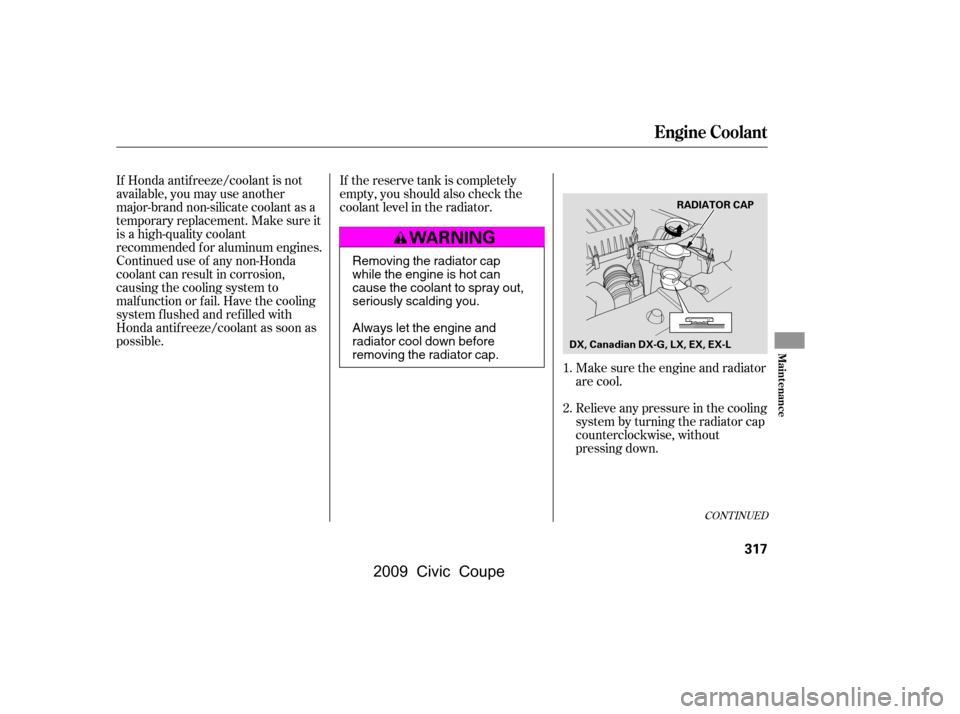Page 54 of 412
CONT INUED
These labels are in the locations
shown. They warn you of potential
hazards that could cause serious
injury or death. Read these labels
caref ully.
If a label comes of f or becomes hard
to read (except for the U.S.
dashboard label which may be
removed by the owner), contact your
dealer f or a replacement.U.S. models
U.S. models only
Canadian models
Saf ety L abels
Driver and Passenger Saf ety
51
RADIATOR CAP SUN VISOR
DASHBOARD
�\f���—�\f���—�\f���y�
�\f����\f��
���y���
�(�+�������\f�y�\f�\f�����y
2009 Civic Coupe
Page 313 of 412
�Î
�Î
Fluid Locations
DX, Canadian DX-G, L X, EX, and EX-L models
310
RADIATOR CAP
WASHER FLUID
(Blue cap)
ENGINE OIL DIPSTICK
(Orange handle)
BRAKE FLUID
(Black cap)
ENGINE OIL FILL CAP
CLUTCH FLUID
(Manual
transmission only)
(Light gray cap)
ENGINE COOLANT
RESERVOIR
AUTOMATIC
TRANSMISSION
FLUID DIPSTICK
(Yellow loop)
: Except for Canadian DX-G with manual transmission POWER STEERING FLUID
(Red cap)
�\f���—�\f���—�\f���y�
�
���������
�y���
�(�+�������\f�y�\f���
���y
2009 Civic Coupe
Page 314 of 412
Fluid Locations
Si model
Maint enance
311
ENGINE COOLANT
RESERVOIR
CLUTCH FLUID
(Light gray cap)
WASHER FLUID
(Blue cap)
RADIATOR CAP
ENGINE OIL DIPSTICK
(Orange handle)
ENGINE OIL FILL CAP BRAKE FLUID
(Black cap)
�\f���—�\f���—�\f���y�
�
�����������y���
�(�+�������\f�y�\f���
���y
2009 Civic Coupe
Page 320 of 412

If Honda antif reeze/coolant is not
available, you may use another
major-brand non-silicate coolant as a
temporaryreplacement.Makesureit
is a high-quality coolant
recommended f or aluminum engines.
Continued use of any non-Honda
coolant can result in corrosion,
causing the cooling system to
malf unction or f ail. Have the cooling
system f lushed and ref illed with
Honda antif reeze/coolant as soon as
possible.Make sure the engine and radiator
are cool.
Relieve any pressure in the cooling
system by turning the radiator cap
counterclockwise, without
pressing down.
If the reserve tank is completely
empty, you should also check the
coolant level in the radiator.
1.
2.
CONT INUED
Engine Coolant
Maint enance
317
RADIATOR CAP
DX, Canadian DX-G, LX, EX, EX-L
Removing the radiator cap
while the engine is hot can
cause the coolant to spray out,
seriously scalding you.
Always let the engine and
radiator cool down before
removing the radiator cap.
�\f���—�\f���—�\f���y�
�
�������
���y���
�(�+�������\f�y�\f�������y
2009 Civic Coupe
Page 321 of 412
Pour coolant into the reserve tank.
Fill it to half way between the MAX
and MIN marks. Put the cap back
on the reserve tank.
Do not add any rust inhibitors or
other additives to your vehicle’s
cooling system. They may not be
compatible with the coolant or
engine components.
The coolant level should be up to
the base of the f iller neck. Add
coolant if it is low.
Pourthecoolantslowlyand
caref ully so you do not spill any.
Clean up any spill immediately; it
could damage components in the
engine compartment.
Put the radiator cap back on, and
tighten it fully.
Remove the radiator cap by
pushing down and turning
counterclockwise.
3. 4.
5.6.
Engine Coolant
318
Si
SiRESERVE TANK
RADIATOR CAP RESERVE TANK
DX, Canadian DX-G, LX, EX, EX-L
�\f���—�\f���—�\f���y�
�
�����������y���
�(�+�������\f�y�\f�������y
2009 Civic Coupe
Page 363 of 412

Put the radiator cap back on
tightly. Run the engine, and check
the temperature gauge. If it goes
back to the red mark, the engine
needs repair (see
on page ).
If you do not see steam or spray,
leave the engine running and
watch the temperature gauge. If
the high heat is due to overloading,
the engine should start to cool
down almost immediately. If it
does, wait until the temperature
gauge comes down to the midpoint,
then continue driving.
If the temperature gauge stays at
the red mark, turn of f the engine.
Look f or any obvious coolant leaks,
such as a split radiator hose.
Everything is still extremely hot,
so use caution. If you f ind a leak, it
must be repaired bef ore you
continue driving (see
on page ).
If you don’t f ind an obvious leak,
check the coolant level in the
radiator reserve tank (see page
). Add coolant if the level is
below the MIN mark.
Start the engine, and set the
temperature control dial to
maximum heat. Add coolant to the
radiator up to the base of the f iller
neck. If you do not have the
proper coolant mixture available,
you can add plain water.
Remember to have the cooling
system drained and ref illed with
the proper mixture as soon as you
can.
If the temperature stays normal,
check the coolant level in the
radiator reserve tank. If it has
gone down, add coolant to the
MAX mark. Put the cap back on
tightly.
Using gloves or a large heavy
cloth, turn the radiator cap
counterclockwise, without pushing
down, to the f irst stop. Af ter the
pressure releases, push down on
the cap, and turn it until it comes
off.
If there was no coolant in the
reserve tank, you may need to add
coolant to the radiator. Let the
engine cool down until the reading
reaches the middle of the
temperature gauge, or lower,
bef ore checking the radiator.
7.
8.
9.3.
4.
5.
6.
10.
11.370
269
370
Emergency
Towing
Emergency
Towing
If theEngineOverheats
360
Removing the radiator cap
while the engine is hot can
cause the coolant to spray out,
seriously scalding you.
Always let the engine and
radiator cool down before
removing the radiator cap.
�����—�����—�����y�
�
�������
���y���
�(�+���������y���������y
2009 Civic Coupe